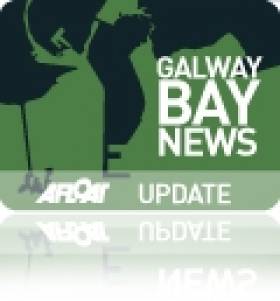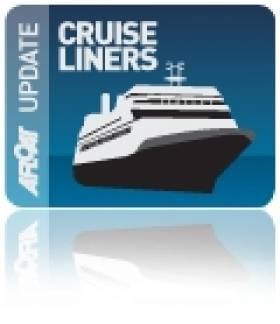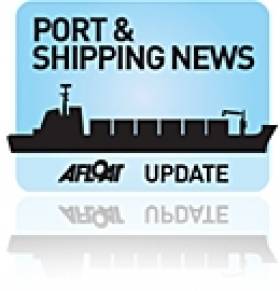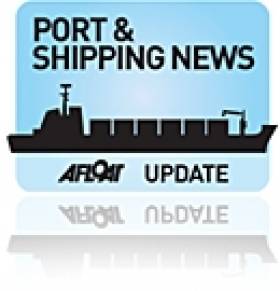Displaying items by tag: expansion
Across the Irish Sea at the Port of Liverpool, the owners Peel Ports Group have welcomed an additional five cantilever rail-mounted gantry (CRMG) container shipping cranes that arrived at the UK port from China.
The delivery which was completed last week forms part of the next phase of growth at Liverpool2, the Merseyside port’s deep-water container terminal (which last month Afloat adds broke its own volume handling record twice).
Produced by leading Chinese manufacturer, Zhenhua Heavy Industries Co (ZPMC), the five new cranes are the first of two deliveries in 2021, which will complete the set of 22 CRMG cranes operating as part of the £400 million Liverpool2 project, and will provide additional capacity for growing volumes of cargo.
Ready for installing and commissioning, the arrival of this consignment marks the end of a 46 day journey of over 11,831 nautical miles from Shanghai, China. Each crane measures 35 metres in height with a weight of around 500 tonnes. Once completed, the site will have a total of eight STS and 22 CRMG cranes.
David Huck, Managing Director, Peel Ports Group said: “The dynamism and strength of the business gives us the confidence to continue to grow and invest. Throughout 2021, future-proofing will be at the forefront of our business model, driving forward with planned investments in our people, processes and technology.
“We are on course to achieve our ambitious growth plans to drive UK container market share to 20% by 2025. Liverpool2 is already one of the world’s most modern shipping terminals and we have no plans of slowing down any time soon. This recent delivery is testament to this and adds to three additional ship-to-shore cranes already delivered into live operations in December 2019.”
As one of the most operationally efficient and modern terminals in Northern Europe, the deep-water terminal offers ‘future-proof’ facilities, giving global shipping companies reliable access to major import and export centres at the heart of the UK.
David added: “The combination of Brexit-related changes and the impetus provided by COVID-19 has highlighted the vulnerability of supply chains to disruption, prompting a significant number of businesses to look at bringing more activity back to the UK.
“Working closely with the world’s leading shipping lines, we hope to encourage more services to the Port of Liverpool to help alleviate some of the pinch points on supply chains that have previously relied on Southern ports. Improving supply chain resilience could help to support the UK Government’s levelling up agenda by rebalancing economic activity away from the South towards areas in the North.”
Peel Ports Group, in conjunction with its partner global terminal business, Terminal Investment Limited Sarl (TiL), is continuing to develop the deep-water terminal which includes the multi-million expansion at Liverpool2, to further increase capabilities and support increased demand.
Once completed, the £400m container terminal will be capable of handling the largest ships in the world, whilst supporting the UK haulage sector via the very latest landside automated gates and vehicle booking systems.
Work on this second phase of the landside project is expected to be fully completed in the summer 2021 and will be supported by over 150 new skilled jobs on Merseyside.
UK Ports Group Expands Logistics Service With Acquisition At Port Close to River Mersey
A UK ports operator, Peel Ports Group which includes the Port of Liverpool, has announced it has acquired Quality Freight (UK) Limited for an undisclosed amount.
The company acquired provides chartering and a range of port services operating from a 40 acre multi modal facility at Ellesmere Port in Cheshire. The port located on the Manchester Ship Canal connects to the River Mersey.
Commenting on the acquisition, Mark Whitworth, Chief Executive of Peel Ports Group said: “Our strategy is to be a leading UK provider of port centric logistics solutions. The acquisition of Quality Freight (UK) Limited is an important step in extending the range of value added services beyond the core stevedoring and storage services typically offered by Peel Ports. We are looking to drive additional volume through our infrastructure and the Quality Freight business model will allow us to deliver that objective.”
Sebastian Gardiner, who will be continuing in the role of Managing Director of the business which will continue to trade under the Quality Freight name, commented: “I believe that this is an important milestone which will allow the Quality Freight business to both continue growing and allow it to explore other opportunities with existing and new customers.”
Galway Port Expansion Verdict Delayed Again
#GalwayPort - Planners' verdict on multi-million euro expansion plans for Galway Harbour have been postponed for another four weeks, according to Galway Bay FM.
As previously reported on Afloat.ie, the planning appeals board has gone back and forth on the €126 million docks redevelopment scheme since January's oral hearing, and was originally set to announce its decision yesterday (Friday 11 September).
However, that date has now been revised by An Bord Pleanála to Friday 9 October, the latest postponment for a decision previously expected in early August, and before that in early summer.
Tomorrow Is Last Day For Submissions On Galway Port Expansion
#GalwayPort - Galway Bay FM reports that more than 50 submissions - the majority of them supportive - have been made to An Bord Pleanala on proposals for the expansion of Galway Port in the public consultation that closes tomorrow Tuesday 11 March.
As previously reported on Afloat.ie, the plans as lodged involve a significant 27 hectare expansion of the port's footprint into Galway Bay, a move seen as "critically important for the economic future of the entire western region" according to Galway Harbour company chief executive Eamon Bradshaw.
The port extension will also see most harbour-related activities relocated from the existing dock area to the new deepwater berths, quays, jetties and yards that are expected to future-proof the port to accommodate larger shipping and cruise liner traffic.
While the notion of reclaiming land from the harbour has sparked some concern among local residents and businesses taking stock after a damaging series of storms and their attendant floods earlier this year, the city's harbourmaster said in January that such flooding will occur more regularly "with or without" the port expansion.
Belfast Harbour Plans Expansion Into Lough
#BelfastLough - Some 60 acres (25 hectares) would be reclaimed from Belfast Lough under ambitious proposals to expand Belfast Harbour that have been lodged with planning authorities.
BBC News reports on the three-year scheme planned for the seaward end of Victoria Terminal Four from where Stena Line's Scotland routes currently sail.
Among those welcoming the harbour's move is the local quarry industry, which would provide the six million tonnes of infill rock needed to reclaim the land from the lough.
The news comes hot on the heels of Galway Harbour's own planning application to expand into Galway Bay with berthing space to attract more sea traffic, including the future generation of cruise liners.
Largest Residential Cruise Liner is Galway Bound
#CruiseLiners - The world's largest residential cruise liner is set to visit the City of the Tribes next week, according to the Galway Independent.
The floating town known as The World is expected to arrive in Galway Bay next Monday 8 July for a single night's stay after a similar stop this morning at Belfast and later this week at Derry.
Distinct from other cruise liners that ply the oceans, The World comprises a residential community of some 130 families who between them own the 12-deck, 200-metre-long vessel.
Galway Harbour Master Captain Brian Sheridan described The World's visit as "a great opportunity to showcase the city and the region to its passengers and a welcome economic boost" - despite the ship being too large to enter Galway's inner harbour.
Providing berthing space for the modern generation of cruise ships is one of the goals of the planned expansion of Galway Port, though it emerged this week that the planning application had still not been submitted to An Bord Pleanála.
The Galway Independent has more on The World's visit HERE.
Galway Port Expansion '99 Per Cent Ready To Go'
#GalwayHarbour - Plans for the expansion of Galway Harbour are "99 per cent ready to go", as the Galway Independent reports.
Eamon Bradshaw, CEO of the Galway Harbour Company, said that the application for the new development would be submitted by the end of June.
As previously reported on Afloat.ie, the scheme will be the first Irish project lodged under new legislation that provides for planning permission on the grounds of "overriding public interest".
Bradshaw says that the necessary Natura Impact Statement has been completed, and economic and financial details were now being finalised for the redevelopment project at the harbour, recently recognised by the Government as a 'port of regional significance'.
Should it get the go-ahead from An Bord Pleanála, the new harbour will extend almost 1km out to sea with 660m of quay berth and plenty of space for cargo and container ships, oil tankers, fishing vessels and passenger ships.
The project will be completed in four phases, with the first €50 million phase extending the port by some 57 acres to accommodate a greater number of commercial ships and modern cruise liners.
Galway City Council recently granted extra time to the Galway Harbour Company for pre-expansion demolition works in the docks area.
The Galway Independent has much more on the story HERE.
Galway Harbour Co Gets Extra Time for Pre-Expansion Works
#GalwayPort - Galway Bay FM reports that the Galway Harbour Company has been given extra time by city councillors for the demolition of buildings in the docks area to make way for the upcoming port expansion.
Planning permission was granted five years ago for the removal of the Centre Pier building, which had been earmarked at the time as the location for a media centre for last summer's Volvo Ocean Race finale.
Now the Galway Harbour Company has three more years as it seeks further planning permission for the first phase of its expansion plans, as previously reported on Afloat.ie.
Belfast Invests in Port's Future
Belfast Harbour's new corporate plan details investments worth £92m (€103m) in improving the port and supporting renewable energy.
Handy Shpping Guide reports that the single biggest investment in the three-year-plan is a £40m (€44.7m) scheme for a logistics terminal to support offshore wind farms in the Irish Sea.
While the port acknowledges that the economic downturn means only marginal growth is forecast for tonnages through the Port of Belfast, it says "significant opportunities" exist in diversitying into other sectors such as the 'green economy'.
Belfast Harbour commercial director Joe O’Neill says the corporate plan also "sets the framework" for future development and expansion of the port over the next 20 years.
Expansion Is The Only Way Says Dublin Port Chief
Trade at Dublin Port is set to more than double over the next 30 years, according to its chief executive Eamonn O'Reilly.
In an interview with The Irish Times last week, O'Reilly elaborated on the new 'master plan' for the port, which is based on an estimated trade growth to 60 million tonnes (or 2.5% annually) by 2040.
“Last year’s growth [of 6.1%] suggests to me that we need to get our planning caps on and get a solid and robust master plan in place,” said O’Reilly.
The master plan, according to the Dubin Port chief, will require expansion of the existing port by reclaiming up to 40 hectares, as well as a greater integration with bordering areas.
Previous attempts to expand have faced much opposition from conservation groups and local residents for a number of years.
O’Reilly stressed that the local community will be engaged on the issues involved before Dublin Port produces a final proposal at the end of the year.
But he also insisted that "there’s no project [that hee knows of] for port expansion that doesn’t involve reclamation", despite proposals to establish a new port at Bremore.
Read more of the Irish Times interview with Eamonn O'Reilly HERE.





































































